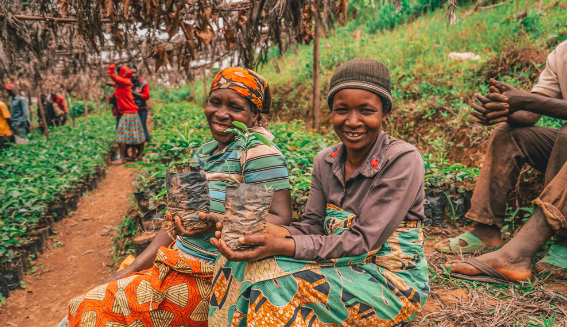

The goal of the project is to contribute to the reduction of greenhouse gas (GHG) emissions from deforestation and forest degradation while contributing to the reduction of poverty among populations in THE PROVINCE OF TSHUAPA, the basins of Mbuji-Mayi (Kasaï Oriental), Kananga (Kasaï Occidental) and Kisangani (Province Orientale).
The program aims to encourage people to conserve their forests and improve their forest management to reduce greenhouse gas emissions.
It addresses the main drivers of deforestation and forest
degradation, particularly relating to land security, agriculture, forestry and biomass energy.
we are working in the implementation of sustainable forest management practices in a degraded savannah zone (Mbuji-Mayi/Kananga) and a dense forest zone DE LA TSHUPA (Bondo, Yangambi, Basoko, Watsa, Opala, Kungu) .


The project relies on land use planning and payment for environmental services (PES) as the main implementation modalities.
Project activities are implemented through in-kind PES, based on communities’ compliance with agreed plans for land use.
Payments in kind based on the results obtained are also made for tree planting activities instead of conventional cash remuneration for work.
The duration of the project is five years and its total cost is estimated at $22.10 million USD.
The main beneficiaries of the project are local communities, indigenous peoples and the private sector.
The direct beneficiaries are estimated at 50,000 households or 400,000 people.
The GHG reduction likely to be achieved by the project over a period of 10 years is estimated at around 6 million tonnes of CO2 equivalent.


Near the Congo River, the largest complex of tropical peatlands in the world is home to a very rich ecosystem.
But also hydrocarbon deposits. If these wetlands were destroyed, the immense amount of carbon they hold would be released into the atmosphere.

The result of thousands of years of accumulation of organic matter in this swamp forest watered by the Congo River, this fragilely balanced ecosystem is an extremely efficient carbon sink. The approximately 150,000 square kilometers of wetlands identified in this region of central Africa would contain the equivalent of twenty years of CO2 emissions from the United States. They could release them into the atmosphere if the marshes were to be dried up or destroyed. “Local communities therefore bear a very heavy responsibility, that of protecting the peatland,” assures the photographer.
We collaborate with local leaders, organizations, and government agencies to strengthen conservation efforts. By building partnerships, we ensure a holistic approach that addresses both environmental and community needs.

HOW WE WORK



We actively involve local communities in decision-making processes regarding conservation initiatives. By including their perspectives and knowledge, we create a sense of shared responsibility for protecting the environment.
We strive to provide alternative livelihood opportunities to communities that rely on natural resources. By introducing sustainable income-generating activities, we aim to reduce dependency on activities that harm the environment.
We conduct educational programs to raise awareness about the importance of preserving the rich biodiversity of Congo. Through workshops, training sessions, and outreach programs, we empower individuals with knowledge about sustainable practices.

Expanding Our Impact: Introducing Carbon Credit Trading
We are excited to announce our new venture into the carbon credit market as part of our commitment to nature conservation. By participating in carbon credit trading, we aim to offset carbon emissions and promote sustainable practices that benefit both the environment and local communities.
Through this initiative, we will work with businesses and organizations to measure, reduce, and offset their carbon footprint. The funds generated through carbon credit trading will be reinvested in conservation projects that help protect and restore natural ecosystems.
Join us in our efforts to combat climate change and support nature conservation through carbon credit trading. Together, we can make a positive impact on the environment and create a more sustainable future for all.



